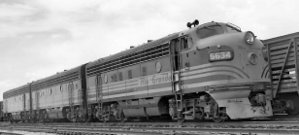EMD F7
2007 Schools Wikipedia Selection. Related subjects: Railway transport
 D&RGW #5634 in 1950; this early Phase I locomotive was delivered in July, 1949 |
|
| Power type | Diesel-electric |
|---|---|
| Builder | General Motors Electro-Motive Division (EMD) |
| Model | F7 |
| Build date | February 1949 – December 1953 |
| Total production | 2,366 A units, 1,483 B units |
| AAR wheel arr. | B-B |
| Gauge | 4 ft 81⁄2 in (1435 mm) |
| Power output | 1,500 hp |
| Locale | North America |
The EMD F7 was a 1,500 hp B-B freight-hauling diesel locomotive produced between February, 1949 and December, 1953 by General Motors' Electro-Motive Division. Final assembly was at GM-EMD's La Grange, Illinois plant. A total of 2,366 cab-equipped lead A units and 1,483 cabless booster B units were built. The F7 was the fourth model in GM-EMD's highly successful F-unit series of cab unit freight diesels, and it was the most produced of the series. The F7 can be considered the zenith of the cab unit freight diesel; it was ubiquitous on North American railroads until the 1970s (longer in Canada), and the design has become entrenched in the popular imagination.
The F7 replaced the F3, differing only in internal equipment (mostly electrical) and was succeeded by the more powerful F9.
Identification
There is no easily identifiable differences between late F3 production and early F7 production; the major differences were all internal electrical system changes. However, no F7 had the "chicken wire" grilles of most F3s, and no F3s had the later F7 changes described below under Phases.
The EMD F9 is distinguishable from the late F7 by having five, rather than four, carbody centre louver groups covering the carbody filters. The additional one is placed ahead of the first porthole, where F7s have no openings. The F9's greater power output, of course, cannot be seen from the outside.
Phases
The identification of locomotive "phases" is a creation of railfans. EMD used no such identification, and instead kept track of the marketing name (F7) and individual locomotives' build numbers. During the production cycle of a model, EMD would make changes. To keep better track of the variations of locomotives identified the same by the manufacturer, railfans began referring to phases (critical changes to a locomotive line).
Despite not being official designations, the phase description is useful. However, many of the changes described are cosmetic, easily changed features of a locomotive; roof fans, body panels, grilles and the like could be and sometimes were updated or swapped. Most of the phase differences on the F7 were concerned only with A units; B units varied far less. The following are normally identified as F7 phases:
Phase I (early)
Built from February 1949. Upper grille with horizontal openings. Four horizontal louvred openings on centre body panel. 36 inch dynamic brake fan. Flush windshield gasket changed to raised in July 1949. Square cab door corners with kick plates on the steps beneath. Wing window short with square corners. Single drip strip over cab windows and door. Square end door window. Round sand filler cover. Rear overhang.
Phase I (late)
Built from March 1950. Upper grille started out horizontal, as in early Phase I; from March 1951, some locomotives were built with vertical-slotted "Farr-Air" grilles, and by October 1951, all had them. Cab doors became round-cornered, and the kick plates were deleted. The wing windows became larger, with round corners. Two drip strips; one over cab windows, second over door. The end door window became round after November 1950.
Phase II
Built from February 1952. All upper grilles vertical "Farr-Air" type. Centre car body louvres became vertical-slotted. Sand filler now with a horizontal, rectangular pull handle. From June 1952, 48 inch dynamic brake fans began to be introduced; from October 1952, all dynamic-brake equipped locomotives had them. At that latter date, locomotives no longer had a rear overhang.
|
A former Baltimore and Ohio Railroad F7A falls under the cutting torch at the Naporano Iron & Scrap Works in Newark, New Jersey in 1975. The majority of the carbody has been removed, exposing the sixteen-cylinder EMD 567 series prime mover. |
Deliveries
Original owners of the EMD F7 include:
| Railroad | Cab-equipped 'A' units | Cabless booster 'B' units |
|---|
Preservation
The Western Pacific Railroad Museum at Portola, CA rosters two former Western Pacific F7As: WP 917-D and 921-D. These engines are part of the museum's popular "Run a locomotive" program.

